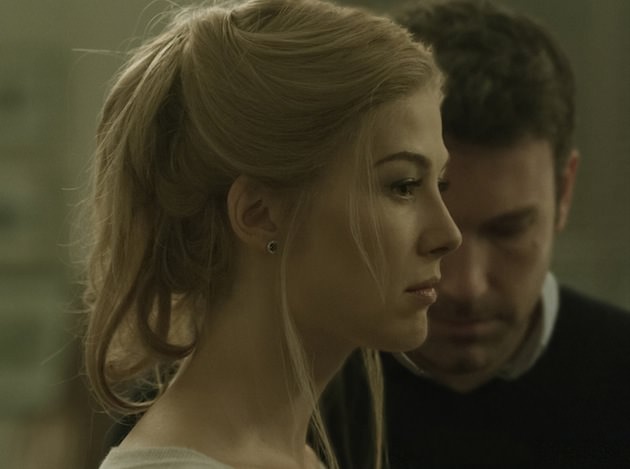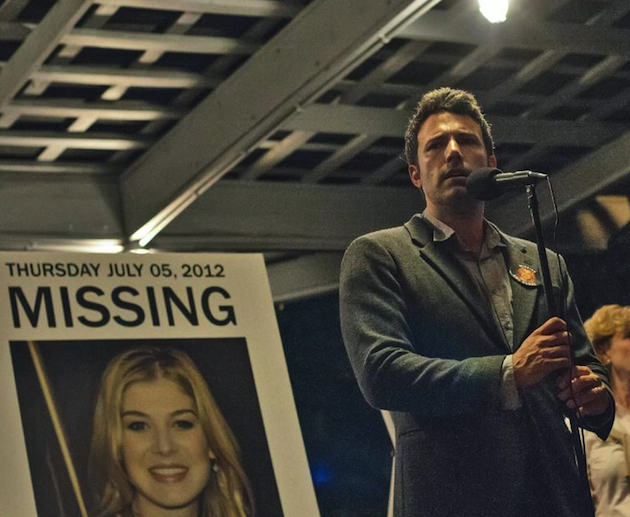Longtime Collaborators Helped David Fincher Find Gone Girl
The New York Film Festival kicked off with the world premiere of David Fincher’s Gone Girl last Friday, and boy, did it deliver. Fincher’s directing chops are never in question, and Gillian Flynn’s novel is perhaps perfectly suited for his particular skill set. Gone Girl combines his instinctual way around pitch-black thrillers (Se7en, Zodiac, The Girl With the Dragon Tattoo), and offbeat, grimy comedies (Fight Club) and delivers 148 compelling minutes without any evident lull.
While Fincher and Flynn deserve a ton of credit, there were plenty of people who helped bring Flynn's 2012 best seller to crackling life. Four of these individuals are longtime collaborators of his; cinematographer Jeff Cronenworth (his sixth Fincher film), production designer Donald Graham Burt (five previous collaborations), and composers Trent Reznor and Atticus Ross (their third collaboration). Through these collaborator’s well take a quick, spoiler-laden look at how they helped Fincher and Flynn find their cinematic Gone Girl.
Again, folks, spoilers below.
Menacing McMansions
Production designer Donald Graham Burt deserves a ton of credit for helping Fincher turn Nick’s hometown of Carthage, Missouri into a place of surface comforts and deep troubles. Burt won an Oscar for Art Direction for his work on The Curious Case of Benjamin Button with Fincher, and while his work here is more subtle, audiences will react to the world of confining comfort he has helped craft around Nick (Ben Affleck) and Amy Dunne (Rosamund Pike).
The film was shot in Cape Girardeau, a Missouri river town a little more than 100 miles outside of St. Louis. Nick and Amy’s life in Carthage is superficially perfect – two attractive people living in a big house in a nice part of town – but the true picture is one of debt, increasing desperation and isolation. Cape Girardeau gave Burt a mixture of pretty McMansions and leafy suburbs, lower income areas, abandoned storefronts and a hodgepodge of architectural designs. “Everything about Cape Girardeau was right,” Burt said in the press notes. “From its mix of different levels of economics and period architectures from the 60s, 70s and 80s to its sprawling malls to having the river there as an anchor.”
The most important location of all was the Dunne household, a large place where Nick and Amy could share a home but remained apart, something not too ostentatiously huge and vulgar, but one that, upon closer inspection, seems to be falling apart. The house they settled on had elements, like the wood, that seemed of a piece with the beautiful New York brownstone they had to give up, but “in a skewed way,” Burt said. “It’s as if the house yearns to be traditional…but the hardware and the light fixtures and the vinyl windows give it away.”
The house itself is schizophrenic, a place with large rooms, a beautifully appointed bedroom, a fetching all glass shower—yet nothing that happens in these spaces matches the rich, reasonable suburban milieu. From the moment Nick comes home to the broken glass coffee table and signs of a struggle (and no Amy), the Dunne household slowly begins to reveal itself as the place where everything came unraveled, a large, superficially beautiful insane asylum.

Favorite Spoiler-y Moment in the Dunne Household: The bloody shower that Amy and Nick take together, a sort of reverse Psycho that leaves Nick sputtering in confusion at his wife's lunacy. There was something so unsettling about such a creepy moment in such a Bed, Bath & Beyond-like bathroom.
The Sound of a Massage Going Horribly, Horribly Awry
Having honed their process with Fincher over The Social Network and The Girl With the Dragon Tattoo, composers Trent Reznor and Atticus Ross happily cop to a method that takes much, much longer than what would be usual, but which bears such wonderfully strange and potent sounds. Starting on the score long before they see a single reel of the film (an unusual way to work for a composer), the two musicians continuously hone their work as Fincher and his team stitch the film together. “We work almost subconsciously based often just on textures and swatches,” Reznor said in the production notes. “After a few weeks of working this way, we’ll turn in some music to see if what we are doing is resonating with what’s in David’s head. It probably takes about 30 times as long to work in this way but it’s what feels right.”
The score feels very right, perfect, in fact, and cements the Fincher/Reznor/Ross collaboration as one of modern cinema’s most exciting director/composer collaborations, along with Paul Thomas Anderson and Jonny Greenwood and, you’ll get to know them better in the coming months and years, Damien Chazelle and Justin Hurwitz.
Fincher told The Wall Street Journal that he got an idea for the score while getting his back adjusted at a spa: “I was listening to that calming, placating music and thought, ‘We need to tap into this.’ The movie is about the façade of the good neighbor, the good Christian, the good wife.” Reznor said that this massage table music idea was the kick off point for the score. “We thought, what if we start with something that is almost grotesquely sweet and then reveal what’s under the surface. We incorporated spa-like moments, but then explored how to make them turn unpleasant, to peel off the layers so you feel the unraveling.”
Reznor and Ross, known for their virtuosity, downscaled their typically robust synthetic soundscape to create something “more organic,” using homemade equipment. At one point, you hear an odd tapping sound that is almost like a heart beating, a little Edgar Allen Poe “The Tell-Tale Heart”-style. It is just Reznor tapping on a wooden box.
The soundtrack starts off sweet and gentle, but as Nick Dunne’s life unravels, the dark hints evident even in those early, peaceful-seeming sounds begin to grow. By the film’s end, we are well below the surface of placid, Suburban Missouri and the facile sweetness of those early songs. Now we're wriggling around in a sonic landscape as twisting and unpredictable as Amy Dunne herself.
If you want to listen to Trent Reznor and Atticus Ross’s entire soundtrack for Gone Girl, click here.
The Eye of the Beholder
A ramshackle abandoned mansion in a rat infested industrial zone outside of a city. A storied Ivy league campus turned into twisted playground for a gifted, troubled genius. A spotless, impeccably designed mansion sitting atop a basement of horrors. Cinematographer Jeff Cronenworth has gone with David Fincher in so many memorably dark directions, from Fight Club to The Social Network to The Girl With the Dragon Tattoo, that it’s no surprise he was able to turn a quaint Missouri town into a place seething with secrets and fraying at the edges.
Described as a noir Americana, and inspired by the photography of Joel Sternfeld, who most famous photographic work, “American Prospects,” included color photos of barren landscapes and ruined towns, Cronenworth used his considerable skills to turn the American Midwest into a place of hidden, dark dimensions.
“You look for ways to take a traditional, mundane small town and a couple’s interpersonal home and subtly transform them into something mysterious,” Cronenworth said. He went on to describe Carthage as a “dusty old wedding gown that’s been kept in the closet.”

One of the ways Cronenworth made the Dunne’s home a discomfiting place was through light. “The Dunne’s house was all about taking a normal, ordinary domestic situation and turning it into an isolated fortress with the blinds drawn down. From small details comes that sense of disenchantment.” Another was by shooting many scenes from slightly below eye-level, catching a snatch of the ceiling above Nick's head to make him feel caged in his predicament.
To pick just one spoiler-y standout moment among many, there's the one and only gory scene in the entire film, which begins with Amy treating Desi (Neil Patrick Harris) to some rough sex, and ends with the incredible shot of her straddling him, covered in his blood. WIll she start weeping at what she's done? Nope, just a flick of the head to get her her hair out of her eyes.



